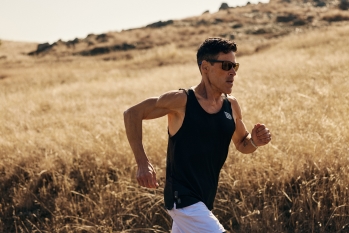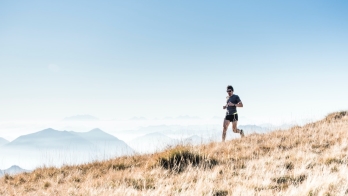What causes runner’s stomach and how to prevent it
Runner's trots. A phenomenon that no runner wants to experience, yet it's remarkably common. Here's what causes runner's stomach, and how to prevent it with the power of science (of course).

If you’ve ever had to peel off into the woods mid-run for an emergency bathroom stop or have plotted out your running routes around bathroom accessibility, you’re not alone. Maybe you’ve heard this phenomenon called ‘runner’s stomach’, ‘runner’s gut’, or ‘runner’s trots’? Whatever term you use, GI distress during a run - be it cramping, gas, diarrhea, or an immediate urge to use the bathroom - is a very real exercise-induced symptom.
If you’re experiencing runner’s stomach more frequently or more intensely than you’d prefer, check out the following list of contributing factors, plus some strategies to help prevent and treat your unsettled tummy.
What causes runner’s trots?
Reports indicate anywhere from 30%-90% of runners have experienced runner’s stomach [1] [1]
Running mechanics
Sympathetic nervous system (aka flight or fight system) activity increases during a run, which redirects blood flow away from your digestive system, towards the heart and working muscles [2]. Reduced blood flow and motility in the gut are believed to be the main factors behind a raft of runner’s trots symptoms including gassiness, cramping, and urgency. The repetitive mechanics of running are also thought to exacerbate GI distress [1]
Stress response
The body perceives running as a form of acute (short-term) stress, increasing heart rate and releasing hormones such as cortisol, adrenaline, and noradrenaline into the bloodstream. Exercise-induced stress not only diverts blood flow from the GI tract but also can compromise intestinal microbiota composition, leaving you with an unsettled stomach [3].
Pre-run food choices
Stomach comfort (or discomfort) on a run is also influenced by what you eat pre-run (and when). The wrong type of fuel and/or poor timing can be the difference between crushing your workout and suffering through nausea, cramping, and emergency bathroom stops. What works for one may not for another so experimentation in training is key. That said, there are some general principles for you to consider if you’re experiencing mid-run GI distress (see below).
Dehydration can also contribute to runner’s stomach. Lack of blood flow to the intestinal tract, paired with inadequate fluid, can result in the sudden onset of diarrhea or cramping.

Tips for minimizing runner’s stomach
Timing your intake to minimize GI distress during a run
Eating the wrong thing too close to a run is a common mistake amongst runners. Aim to eat your last full meal 2-4 hours before your run to minimize your chances of GI distress. If you need to top off your fuel stores 1-2 hours before you lace up your sneakers, go for easily digestible carb-rich options such as a banana, jam on toast, or instant oatmeal. Fat and fiber generally digest more slowly and can leave you full, crampy, and running to the bathroom mid-run when consumed too close to your workout.
If you have a long run planned and need to refuel midway through, aim for a combination of 30-60g of easily-digested carbohydrates per hour, split 20-minute increments, to minimize GI discomfort. Mid-run fueling is all about getting in a little glucose without straining your digestive tract. Honey sticks, gels, sports drinks, and candy (yes, candy!) are all good options for topping up your glucose supply while you’re accruing miles on foot [4] [2]
Whether you’re completing a marathon or a shorter race, training is the best place to experiment with and tweak your nutrition plan for race day. Some people can tolerate gels before and during a run, while others find that consuming such a concentrated dose of carbohydrate is too much for their GI tract. (More on nutrition for runners here
Low FODMAP diet for runner’s stomach
For runners with particularly sensitive stomachs or persistent GI symptoms, consuming a low FODMAP diet [5]

Hydration and runner’s gut
Adequate hydration before and during a run can help minimize your risk of runner’s trots (and improve performance).
Before a run: Sip water frequently and aim for urine lemonade-colored or lighter.
During a run: If you’re going long, running in hot conditions, and/or you’re a heavy sweater, a combination of fluid and electrolytes can be helpful for maintaining hydration and minimizing your risk of runner’s stomach.
Aim for ½ cup of water/ sports drink every 15 minutes.
Some runners find that sports drinks exacerbate GI symptoms during a run. If this is you, you have a couple of options:
Try another brand of sports drink;
Try alternating between water and sports drinks, or mixing the two together;
Go with a low-carb electrolyte drink (like Nuun) and try getting carbohydrates from another source like honey sticks, or candy
Improving gut health
Optimizing gut health before you even think about lacing up your running shoes is arguably the best way to prevent runner’s stomach and mitigate your mid-run symptoms. Your gut contains both good and bad bacteria however, the balance between them can get thrown out of whack during repeated bouts of physical (and emotional) stress. This is often referred to as dysbiosis and if left unchecked, it can lead to a host of health issues including GI distress.
So, what can you do to keep your gut in tip-top shape between runs? Below are a few tips:
Eat a varied diet rich in fiber (from vegetables, fruits, and whole grains)
Incorporate fermented foods such as yogurt, kombucha, kefir, and sauerkraut, daily
Consume prebiotic-rich foods such as oats, garlic, leeks, asparagus, bananas, regularly. Prebiotics nourish ‘good’ gut bacteria.
Consider a probiotic supplement. Probiotics are the ‘good’ bacteria that confer a health benefit. Some evidence suggests that supplemental probiotics may be helpful for reducing GI distress in athletes, however, the benefits appear to be strain and dose-specific so consult a Registered Dietitian for specific recommendations
[6]
.

Consider your supplements
Some supplements and ergogenic aids can cause GI symptoms and exacerbate runner’s gut. For example, GI distress is a well-known side effect of sodium bicarbonate [7]
Summary
If you’re a distance runner,
Disclaimer: The text, images, videos, and other media on this page are provided for informational purposes only and are not intended to treat, diagnose or replace personalized medical care.
Key takeaways
Although not fully understood, reduced blood flow to the gut, diet, hormones and the sheer mechanics of running are thought to be the main causes of GI distress during a run [1].
Aim to eat your last full meal 2-4 hours before your run to minimize your chances of GI distress.
For runners with particularly sensitive stomachs or persistent GI symptoms, consuming a low FODMAP diet can be helpful in the days preceding a race [5].
Adequate hydration before and during a run can help minimize your risk of runner’s trots and improve performance.
References
de Oliveira, E. P., Burini, R. C., & Jeukendrup, A. (2014). Gastrointestinal complaints during exercise: prevalence, etiology, and nutritional recommendations. Sports medicine (Auckland, N.Z.), 44 Suppl 1(Suppl 1), S79–S85. https://doi.org/10.1007/s40279-014-0153-2
ter Steege, R. W., & Kolkman, J. J. (2012). Review article: the pathophysiology and management of gastrointestinal symptoms during physical exercise, and the role of splanchnic blood flow. Alimentary pharmacology & therapeutics, 35(5), 516–528.
https://doi.org/10.1111/j.1365-2036.2011.04980.x
Clark, A., & Mach, N. (2016). Exercise-induced stress behavior, gut-microbiota-brain axis and diet: a systematic review for athletes. Journal of the International Society of Sports Nutrition, 13, 43. https://doi.org/10.1186/s12970-016-0155-6
Rosenbloom, C. (2012). Food and fluid guidelines before, during, and after exercise. Nutrition Today, 47(2), 63-69. https://journals.lww.com/nutritiontodayonline/Abstract/2012/03000/Food_and_Fluid_Guidelines_Before,_During,_and.6.aspx
Lis, D. M., Stellingwerff, T., Kitic, C. M., Fell, J. W., & Ahuja, K. (2018). Low FODMAP: A Preliminary Strategy to Reduce Gastrointestinal Distress in Athletes. Medicine and science in sports and exercise, 50(1), 116–123. https://doi.org/10.1249/MSS.0000000000001419
Kerksick, C.M., Wilborn, C.D., Roberts, M.D. et al. ISSN exercise & sports nutrition review update: research & recommendations. J Int Soc Sports Nutr 15, 38 (2018).
https://doi.org/10.1186/s12970-018-0242-y
Office of Dietary Supplements - Dietary Supplements for Exercise and Athletic Performance. (2019, October 17). National Institutes of Health.
https://ods.od.nih.gov/factsheets/ExerciseAndAthleticPerformance-HealthProfessional/







